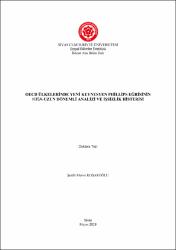| dc.contributor.advisor | Şengönül, Ahmet | |
| dc.contributor.author | Koşaroğlu, Şerife Merve | |
| dc.date.accessioned | 2022-02-17T07:20:44Z | |
| dc.date.available | 2022-02-17T07:20:44Z | |
| dc.date.issued | 2019 | tr |
| dc.date.submitted | 2019-04-12 | |
| dc.identifier.other | XIV, 175 sayfa | |
| dc.identifier.uri | https://hdl.handle.net/20.500.12418/12445 | |
| dc.description.abstract | Makroekonomik göstergelerden enflasyon ve işsizlik arasındaki ilişki iktisatçılar
tarafından yıllardır araştırılmaktadır. Bu amaçla, iki değişken arasındaki ilişkiyi gösteren
Phillips Eğrisi yaklaşımı geliştirilerek buna uygun ekonomi politikaları yürütülmüştür.
İlerleyen dönemlerde gelişen ekonomik koşullar karşısında bu yaklaşım yetersiz kalmış
ve daha sonra mikroekonomik temelinin yetersizliği nedeniyle Yeni Keynesyen İktisadi
yaklaşım geliştirilmiştir. Yeni Keynesyen iktisat temel olarak piyasada oluşan ücret ve
fiyat yapışkanlıklarının nedenlerine odaklanmakta ve bunların sebeplerini teorik olarak
açıklamaktadır. Ayrıca oluşturulan akım rasyonel beklentiler görüşü, aksak rekabet
piyasaları ve eksik bilgi gibi varsayımlara sahiptir. İşsizlik, enflasyon ve ücretler
arasındaki ilişkinin belirlenmesi politika yapıcılar açısından önemli olmaktadır. Yeni
Keynesyen yaklaşım, sabit nominal ücret yaklaşımı yerine ücret ve fiyatların yavaş
ayarlanmasının makroekonomik temellerini araştırmaktadır. Bu yeni akım
varsayımlarına uygun olarak Yeni Keynesyen Phillips Eğrisi farklı değişken ve
yöntemlerle elde edilmiştir. Bu modellerden biri olan Jordi Gali (2011) modelinde Yeni
Keynesyen Ücret Phillips Eğrisini (NKWPC) önermektedir. Gali, NKWPC ile savaş
sonrası ABD verilerini kullanarak bazı kanıtlar sunmuştur. Yeni Keynesyen modelden
türetilen ücretlendirme modeli olan NKWPC’de ücret artışı ve işsizlik arasında güçlü
negatif ilişki olduğunu göstermiştir. Ücret enflasyonu ve işsizlik arasında basit statik
ilişkiyi ifade eden orijinal Phillips Eğrisinin aksine, ücret enflasyonunun mevcut ve
gelecekte beklenen işsizlik oranının bir fonksiyonu olduğu ileriye dönük ilişkiyi
göstermektedir.
Çalışmada temel olarak, OECD ülkelerinde ücret enflasyonu ve işsizlik
arasındaki ilişkinin kısa dönemde bozulması durumunda uzun dönem denge düzeyine
uyarlanma hızlarının, Yeni Keynesyen ücret ve fiyat yapışkanlıkları nedeniyle
değişkenlik göstereceği tezi savunulmaktadır. Savunulan tez doğrultusunda yapılan
çalışmada kısa ve uzun dönemde ücret değişimi ve işsizlik arasındaki ilişkinin değişim
yönünün belirlenmesi amaçlanmıştır. Bu amaçla, Yeni Keynesyen Ücret Phillips Eğrisi
28 OECD ülkesi için 2005:Q1-2017:Q4 dönemine ait verilerle panel veri yöntemi
kullanılarak analiz edilmiştir. Elde edilen sonuçlar, OECD ülkelerinde uzun dönemde
ücret endeksi ve enflasyon arasında pozitif, ücret endeksi ve işsizlik arasında ise negatif
ilişki olduğu yönündedir. Kısa dönemde ise ücret endeksi ve enflasyon arasında pozitif
anlamlı, ücret endeksi işsizlik arasında negatif anlamsız ilişki bulunmuştur. Bu
sonuçlardan hareketle OECD ülkelerinde Yeni Keynesyen Ücret Phillips Eğrisinin uzun
dönemde geçerli olduğu belirlenmiştir. Hâlen dünya ekonomisinde önemli ağırlığı olan
OECD ülkelerinde bu ilişkinin tespit edilmesi, oluşacak şoklara ücret ve fiyatların
vereceği tepkilerin anlaşılması ve dolayısıyla gelecekteki değerlerinin tahmin edilmesine
yardımcı olması beklenmektedir. | tr |
| dc.description.abstract | The relationship between inflation and unemployment of macroeconomic
indicators has been investigated by economists for years. To this end, the Phillips Curve
approach, which shows the relationship between the two variables, was developed and
the appropriate economic policies were carried out. In the following periods, this
approach became insufficient in the face of the developing economic conditions and the
New Keynesian Economic approach was developed due to the inadequacy of its
microeconomic basis. The new Keynesian economics mainly focuses on the causes of
the wage and price tackiness in the market and explains the reasons theoretically. In
addition, this theory has assumptions such as rational expectations, disruptive
competition markets and incomplete information. Determining the relationship between
unemployment, inflation and wages is important for policy makers. The new Keynesian
approach explores the macroeconomic fundamentals of wage and price adjustment
rather than the fixed nominal wage approach. In accordance with assumptions of this
new approach, the New Keynesian Phillips Curve was obtained by different variables
and models. In one of these models, Jordi Gali (2010) proposes the New Keynesian
Wage Phillips Curve (NKWPC). Gali presented some evidence using post-war US data
with NKWPC. Gali showed a strong negative relationship between wage growth and
unemployment in NKWPC, which is a pricing model. Unlike the original Phillips curve,
which denotes a simple static relationship between wage inflation and unemployment,
NKWPC shows a forward-looking relationship where wage inflation is a function of
current and future expected unemployment rate.
In this study, it is argued that the rate of adaptation to long-term equilibrium level
in case of short-term deterioration of the relationship between wage inflation and
unemployment in OECD countries will vary due to the New Keynesian wage and price
stickiness. In the study conducted in line with the defended thesis, it was aimed to
determine the direction of change in the relationship between wage change and
unemployment in the short and long term. In this aim, the New Keynesian Wage Phillips
Curve was analyzed with panel data method for 28 OECD countries with the data
of 2005: Q1-2017: Q4 period. The results show that there is a positive relationship
between wage index and inflation, negative relationship between wage index and
unemployment in OECD countries. In the short term, a positive and significant
relationship between wage index and inflation, and a negative and insignificant
relationship between wage index and unemployment were found. Based on these
results, it can be said that the New Keynesian Wage Phillips Curve is valid in OECD
countries. In OECD countries with significant weight in the world economy, it is
expected that identification of this relationship will help to understand the responses of
wages and prices to crises and so, to predict their future values. | tr |
| dc.language.iso | tur | tr |
| dc.publisher | Sivas Cumhuriyet Üniversitesi Sosyal Bilimler Enstitüsü | tr |
| dc.rights | info:eu-repo/semantics/openAccess | tr |
| dc.subject | İşsizlik | tr |
| dc.subject | Enflasyon | tr |
| dc.subject | Yeni Keynesyen Phillips Eğrisi | tr |
| dc.subject | İşsizlik Histerisi | tr |
| dc.subject | ARDL Modeli | tr |
| dc.title | Oecd Ülkelerinde Yeni Keynesyen Phillips Eğrisinin Kısa-Uzun Dönemli Analizi Ve İşsizlik Histerisi | tr |
| dc.type | masterThesis | tr |
| dc.contributor.department | Sosyal Bilimler Enstitüsü | tr |
| dc.relation.publicationcategory | Tez | tr |















